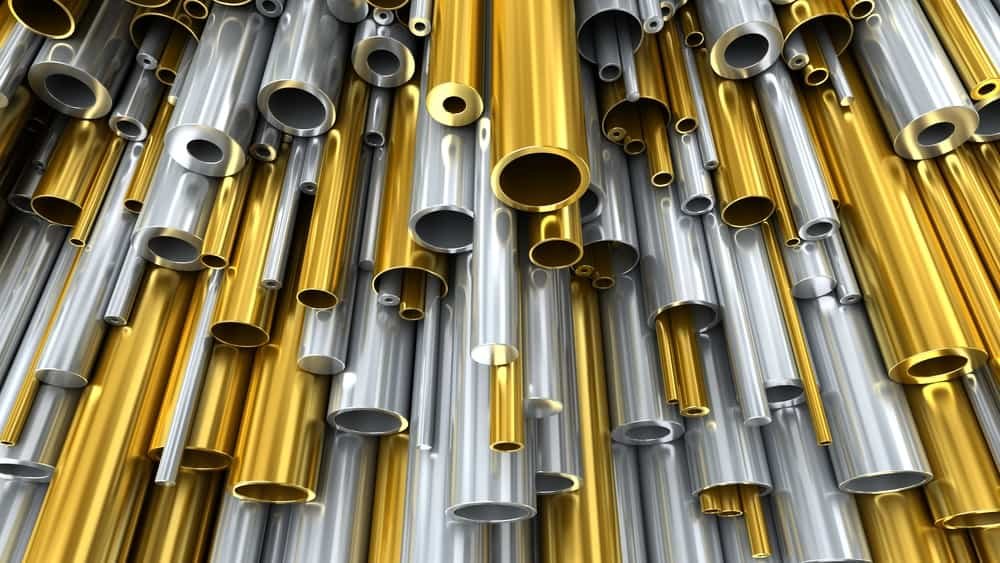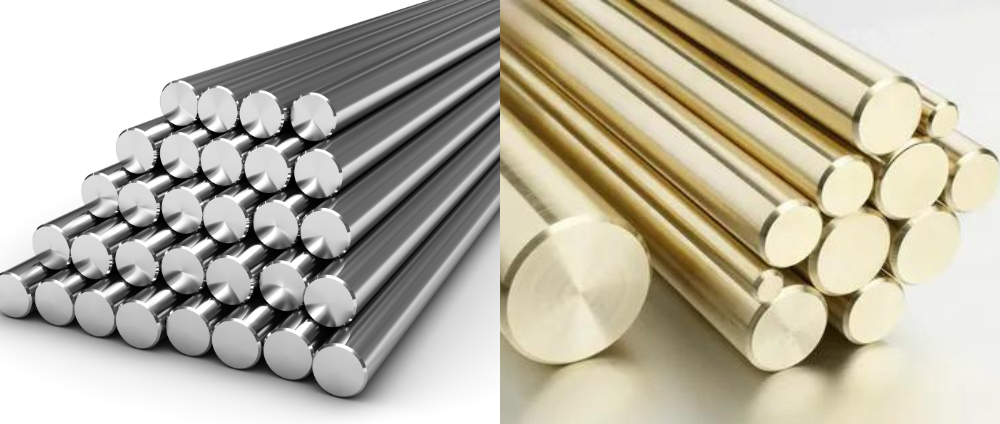Address
304 North Cardinal
St. Dorchester Center, MA 02124
Work Hours
Monday to Friday: 7AM - 7PM
Weekend: 10AM - 5PM
Address
304 North Cardinal
St. Dorchester Center, MA 02124
Work Hours
Monday to Friday: 7AM - 7PM
Weekend: 10AM - 5PM

Brass vs Stainless Steel: Which is the Better Choice? Find Out Here
Hey there, fellow readers! In this article, we’ll explore the unique characteristics, advantages, and typical applications of brass vs stainless steel, helping you make an informed decision. So, let’s roll up our sleeves and get started!

When we think of brass, we envision its warm, golden hue, radiating a sense of elegance. Brass is an alloy primarily composed of copper and zinc, with additional elements like lead or tin added for specific properties.
Its composition can vary, resulting in different types of brass alloys. Apart from its beautiful color, brass boasts excellent malleability, making it easy to shape and form into various architectural and jewelry designs.
Plus, it possesses acoustic properties, making it a popular choice in musical instruments.
On the other hand, stainless steel rocks a modern and sleek appearance. It’s an alloy consisting of iron, chromium, and sometimes other elements like nickel or molybdenum.
Stainless steel comes in different grades and finishes, each offering unique properties and aesthetics.
This versatile material is known for its exceptional strength, durability, and resistance to corrosion, making it a go-to option for many applications.
When it comes to strength, stainless steel takes the lead. Its robust nature allows it to withstand heavy loads and harsh environments, making it a reliable choice for structural components like bridges and buildings.
On the other hand, brass possesses sufficient strength for most architectural applications, such as door handles, railing, and decorative accents. Consider the specific requirements of your project to determine the ideal material.
Architectural design is an art form, and the choice of material plays a significant role in shaping the overall aesthetic.
Brass offers a warm, luxurious appeal, making it a popular choice for traditional and classical styles. Its ability to patina over time adds a unique charm.
Stainless steel, with its contemporary and sleek appearance, is often favored in modern and minimalist designs.
Both materials can create stunning architectural features, so choose the one that aligns with your vision.
Here’s a comparison table highlighting the qualities of brass and stainless steel:
| Qualities | Brass | Stainless Steel |
| Composition | Copper and zinc, with additional elements like lead or tin | Iron, chromium, and sometimes nickel or molybdenum |
| Color | Warm golden hue, patinas over time | Silver, gray, or polished finishes |
| Strength | Sufficient for most applications | Exceptional strength and durability |
| Malleability | Excellent, easy to shape and form | Less malleable than brass, but still versatile |
| Corrosion Resistance | Resistant to atmospheric corrosion, may tarnish over time | Highly resistant to rust and oxidation, maintains a pristine appearance |
| Maintenance | Requires periodic maintenance to prevent tarnishing and corrosion | Low maintenance, easy to clean |
| Cost | Generally more affordable | Relatively higher cost |
| Aesthetic Appeal | Warm, traditional, vintage charm | Modern, sleek, contemporary look |
| Typical Applications | Architectural details, musical instruments, decorative accents, jewelry | Structural components, kitchen appliances, utensils, medical instruments |
Remember that this table provides a general overview of the qualities of brass and stainless steel. Specific properties and variations can exist based on the composition, grade, and finishing of each material.
Jewelry is meant to stand the test of time, so durability is a crucial factor. Brass jewelry is highly durable and can withstand daily wear, especially when properly cared for. However, it’s worth noting that brass may tarnish over time, requiring periodic maintenance.
Stainless steel, on the other hand, excels in terms of durability and wear resistance. It’s highly resistant to scratches, tarnish, and corrosion, making it a perfect choice for long-lasting jewelry pieces.
When it comes to aesthetics, both brass and stainless steel offer distinct qualities. Brass jewelry exudes a warm, vintage-inspired charm that adds character to any outfit. Its ability to develop a natural patina enhances its appeal further.
On the flip side, stainless steel jewelry exudes a sleek, modern vibe that complements contemporary styles. With various finishes available, stainless steel offers versatility and a polished appearance that’s hard to resist.
The cost of brass and stainless steel can vary depending on factors such as alloy composition, grade, and market conditions. Generally, brass tends to be more cost-effective than stainless steel.
However, the price difference can vary significantly based on the specific application and quantity needed. It’s recommended to compare prices and consider the long-term value and durability of each material for your project.
While brass and stainless steel have distinct properties, they can sometimes be used interchangeably depending on the application.
However, it’s essential to consider specific requirements, such as strength, durability, corrosion resistance, and aesthetic preferences. Consult with professionals or experts in the field to determine the most suitable material for your project to ensure optimal results.

Brass is generally resistant to atmospheric corrosion, especially in indoor environments. However, exposure to certain chemicals, moisture, or harsh outdoor conditions can cause brass to tarnish or corrode over time. Applying protective coatings or regular maintenance can help enhance its corrosion resistance and extend its lifespan.
Stainless steel shines in terms of corrosion resistance. Its chromium content forms a passive oxide layer that acts as a barrier against rust and oxidation. This inherent resistance makes stainless steel a reliable choice for applications where exposure to moisture or corrosive substances is a concern.
This was a no brainer but still, let’s take time to meditate on this subject. Stainless steel, primarily composed of iron and chromium, is generally stronger and more corrosion-resistant than brass, which is a copper-zinc alloy.
The chromium in stainless steel forms a protective passive layer of chromium oxide that guards against corrosion, while brass, though naturally corrosion-resistant to some extent, is more vulnerable to dezincification.
Although stainless steel’s strength and resistance are superior, the choice between the two metals often depends on the specific application, given that brass offers benefits like better machinability.
Understanding the differences between brass and stainless steel empowers you to make informed decisions when it comes to architectural projects and jewelry making.
Brass brings a sense of elegance and malleability, making it suitable for architectural accents, musical instruments, and jewelry.
On the other hand, stainless steel offers exceptional strength, durability, and corrosion resistance, making it ideal for structural components, kitchen appliances, and medical instruments.
When considering brass vs stainless steel for architectural projects, assess the specific requirements, including strength, aesthetics, and budget.
Brass provides a warm and traditional look, while stainless steel offers a contemporary appeal. Consider the expected wear and tear, exposure to weather conditions, and maintenance requirements.
In the realm of jewelry, brass and stainless steel cater to different styles and preferences. Brass jewelry exudes a vintage charm with its warm golden hue and patina, while stainless steel jewelry embraces a modern and sleek aesthetic.
Consider the desired durability, resistance to wear, and maintenance needs when selecting the material for your jewelry pieces.
Both brass and stainless steel have their advantages and disadvantages. Brass offers excellent malleability, antimicrobial properties in certain alloys, and cost-effectiveness.
Stainless steel, on the other hand, boasts exceptional strength, corrosion resistance, low maintenance, and hygienic properties.
When it comes to cost, brass is generally more affordable than stainless steel. However, it’s essential to consider the long-term value and durability of each material to make an informed decision based on your specific project requirements.
While brass and stainless steel can sometimes be used interchangeably, it’s crucial to consider the specific properties and performance needed for your project.
Strength, durability, corrosion resistance, and aesthetic preferences play a significant role in determining the most suitable material.
In terms of corrosion resistance, stainless steel outperforms brass due to its chromium content, forming a protective layer against rust and oxidation.
However, with proper maintenance and protective measures, brass can withstand corrosion in indoor environments.
Typical applications of brass include architectural elements, musical instruments, and decorative accents and jewelry.
Stainless steel finds its place in structural components, kitchen appliances, utensils, and medical instruments, thanks to its strength, corrosion resistance, and hygienic properties.
In conclusion, the choice between brass and stainless steel for architectural and jewelry projects depends on various factors such as aesthetics, durability, strength, corrosion resistance, and budget. Consider the specific requirements of your project, consult professionals if needed, and make an informed decision based on the unique properties of each material.
Whether you’re aiming for a classic elegance or a modern sleekness, brass and stainless steel have you covered with their distinct qualities.
Sources:
Copper Development Association: “Brass Alloys for Architectural and Decorative Applications” – https://www.copper.org/applications/architecture/arch_dhb/brass_architectural_applications.html
Stainless Steel World: “Stainless Steel in Architecture, Building & Construction” – https://www.stainless-steel-world.net/ss-pedia/building-and-construction/architecture.html
The International Stainless Steel Forum (ISSF): “Stainless Steel in Architecture, Building and Construction” – https://www.worldstainless.org/Files/issf/non-image-files/PDF/Architecture%20building%20and%20construction%202nd%20edition.pdf
The Copper Development Association: “Copper Alloys – A Guide to the Use and Performance of Copper and Copper Alloy” – https://www.copper.org/applications/compounds/brass_guide/index.html
ASM International: “ASM Handbook, Volume 13A: Corrosion: Fundamentals, Testing, and Protection” – https://www.asminternational.org/home/-/journal_content/56/10192/20393675/BOOK
It’s nice that you mentioned how brass could be shaped and molded into intricate designs easily. I recently got interested in metalworking and I am now going to start some small projects. First off, I’d like to look into some brass selections.